Dooryard citrus has been grown in Georgia for decades, but growing citrus commercially is new to Georgia growers. This publication addresses problem prevention, maintenance, insects, diseases, and some physiological issues of concern in Georgia.
The time of year to address maintenance, insects, disease, and physiological issues is projected. Many of the production practices in Georgia are similar to those in Florida, but some, such as timing of fertility, are different. Many of the known insects and diseases of citrus have been confirmed in Georgia while others are yet to be confirmed.
As new citrus trees and varieties are brought in from citrus nurseries in Georgia and other states, more production issues will arise. Many issues covered in this publication may not be present in all commercial groves, and other issues will certainly arise. Many citrus management problems can be prevented by proper planting techniques and by selecting the best citrus varieties and rootstocks adapted to our location. Planting healthy, disease free citrus trees in appropriate sites with adequate windbreaks and irrigation may prevent future issues and limit the need for many pesticide applications. Consult the current edition of the University of Florida–IFAS Extension Florida Citrus Production Guide for more information and pesticide recommendations.
Preventing production problems
Tree sources: Many insect and disease problems can be brought in with new trees. Trees propagated using certified clean budwood and rootstocks are highly recommended and will prevent many insect and disease problems.
Rootstocks: Poncirus trifoliata rootstocks such as ‘Rubidoux’ and ‘Flying Dragon’ are the current standards for cold hardiness. There are many trifoliate hybrids available, but they may not be as cold hardy as Poncirus trifoliata and little is known about their use with satsumas. Rootstocks can influence tree size, fruit yield, fruit quality, disease tolerance, and other factors. Make sure that the rootstock is adapted to the planting site. In recent years, newer rootstocks have become available that so far have shown some degree of tolerance to Huanglongbing (HLB), or citrus greening disease, but they have yet to be tested with satsumas and many other citrus varieties. For more information on rootstocks consult the University of Florida IFAS Extension’s “Citrus Rootstock Selection Guide.”
Windbreaks: Windbreaks are used to reduce the wind effect in a grove by reducing its speed for a distance of five to 10 times the height of the tree. They are very important in preventing cold damage during an advective freeze and have been shown to disrupt the movement of Asian citrus psyllids (ACP), the vector of HLB, into a grove. They also help by reducing and limiting the spread of citrus canker, which has now been detected in Georgia. Nontropical evergreen tree species used for windbreaks are best established in the winter months, but with irrigation, they can be planted year round.
Planting location: A well-drained, southern-facing slope on a high site is best. Avoid low sites due to frost pockets that could damage trees. Evergreen windbreaks should surround the plantings. At minimum, windbreaks should be on the north and west side. Adjust pH and fertility to 6.0-6.5 if needed before planting.
Planting: Trees should be planted at the same depth they were in the container. Do not cover any of the rootstock with soil. Trees should be planted after the threat of cold weather has passed which is normally around the first of April in U.S. Department of Agriculture zone 8b. Avoid planting trees after July if possible as the tree will have less time to establish before winter.
Freeze protection: In Georgia, freeze protection is very important, especially for young trees. A passive method of freeze protection is correct site selection, particularly by avoiding low sites and planting windbreaks. An active freeze protection strategy used in Georgia are microjets placed on the northwest side of the tree next to the graft union with a minimum of 15 gallons per hour with a 90 degree spray pattern per tree for freeze protection. Microjets placed inside a tree T-Pee or similar device provides increased cold protection but can lead to phytophthora diseases if T-Pees are used year round. Do not use overhead irrigation for freeze protection as it will result in limb breakage.
Fruit removal: Fruit should be removed for the first 2 to 3 years on satsumas to allow for maximum vegetative growth to support a crop and prevent sunburn. Satsuma fruit quality is usually poor on young trees. Other varieties such as 'Tango' can produce good fruit in Year 2.
Cold hardy variety selection: Many factors are involved in determining cold hardiness, such as tree age, variety, rootstock, duration and timing of cold weather, tree health, fertility, and other factors. Kumquats, Changsha mandarins, Ichang lemons, and satsumas are the most cold hardy edible citrus. UGA has released three cold hardy citrus varieties, ‘Sweet Frost’ (changsha), ‘Pink Frost’ (grapefruit), and ‘Grand Frost’ (lemon). Standard satsuma varieties are ‘Owari’, ‘Silverhill’, and ‘Brown Select’. They ripen from early to mid-November. There are many varieties of satsumas that ripen starting in late September but may be lower quality and remain green until cooler temperatures arrive. Mature, cold-acclimated satsumas have withstood temperatures of 12-14 °F in Quincy, Florida, without damage. Mature ‘Minneola’, ‘Sugar Belle’, and navel orange trees have withstood 15-17 °F in Quincy, Florida, with minimal damage to the foliage.
Other citrus varieties: Various lemons, grapefruit, mandarins, and navel and sweet oranges are being planted to add diversity to the industry but have a higher risk for cold damage. Fruit from varieties that ripen after December have a higher risk of freezing on the tree if temperatures reach 28 °F for several hours. Fruit with higher sugar content or a thicker peel can withstand temperatures down to 26 °F. Multiple freezes from December 24–28, 2023, caused more damage to oranges, grapefruit, and non-satsuma mandarins compared to satsuma mandarins.
Rotating pesticide modes of action: Insects, diseases, and weeds can develop tolerances to pesticides when the same mode of action is used repeatedly. Pesticides display a group number on the font of the label. Rotating group numbers is highly recommended to prevent tolerances from developing.
Routine grove maintenance
Postemergence herbicides: Monthly applications may be needed if pre-emergence herbicides are not used. Use postemergence herbicides before applying pre-emergence herbicides if the site is weedy. Burndown herbicides are safer to use on young trees than systemic, broad-spectrum herbicides. Using glyphosate after July can cause fruit drop in some citrus.
Pre-emergence herbicides: Apply in February for summer weeds and again in August for winter weeds. Apply according to labels around newly planted trees. They work best if applied to weed-free ground. Using pre-emergence herbicides will decrease the use of postemergence herbicides.
Fertilization: Soil applications of macronutrients (N, P, K, Ca, Mg, S) is favored over foliar application due to the high uptake demand of citrus. Only a small amount of nutrients can be absorbed by foliage. In Georgia, split fertilizer applications into three parts, mid-March, May 1, and mid-June, using a complete fertilizer. Keep fertilizer away from the trunk and spread it evenly around the tree. Slow-release citrus fertilizers may be applied once in early March to eliminate the need for more applications. In southern parts of zone 8b, fertilization can be split into four applications, including a late July application.* Refer to the citrus maintenance calendar chart. Do not fertilize after July to reduce new growth before winter.
Irrigation: Begin irrigation in spring as trees begin growth and continue throughout the summer. Do not keep the soil saturated, as that promotes root diseases such as phytophthora. A prolonged film of water on the bark also promotes phytophthora infection. Time irrigation early in the morning to reduce prolonged bark wetness. Irrigation in late fall and winter are seldom needed except for freeze protection.
Pruning: Promote the upright growth of satsumas. Varieties such as ‘Owari’ have prostrate growth while ‘Silverhill’ and ‘Brown Select’ grow more upright. For all varieties, remove or prune back limbs that are resting on or near the ground in March before bloom. This will help avoid problems with herbicide application. Remove vertical sprouts and rootstock sprouts on a regular basis throughout the growing season. Excessively long growth can be pruned back to strengthen branches.
Tissue analysis: Take samples in July to early August from the 4- to 6-month-old nonfruiting spring flush. Sample 100 mature spring leaves from 20 healthy trees. Wash leaves with a mild detergent if foliar micronutrients or copper fungicides were applied. Adjust your fertility according to your results.
Insect pests
Citrus leafminer: Drench young trees with imidacloprid before the new growth flush in early May for up to two months of citrus leafminer control, or spray new growth mid-flush for up to two weeks of control. Leafminers should be controlled on young trees as they will slow growth. Drenching is not labeled for trees over 8 feet tall and should be sprayed at that height. Trees with a heavy fruit load may not require a treatment as they usually have a small flush. The first flush in March is not usually significantly attacked in Georgia and treatment is normally not needed (Figures 1 and 2).


Leaf-footed bugs and stink bugs: These insects tend to congregate on certain trees and can damage developing fruit if not treated. Wounds created by these insects can provide entry points for other pathogens. They are sometimes found on blooms in the spring but spring treatment is likely not needed (Figures 3 and 4).


Rust mites: There are two types of rust mites, the pink citrus rust mite and the citrus rust mite (Figure 5 and 6). Rust mite populations can increase rapidly starting in April and peak in July. Populations normally drop after July but can rise again from October to November. Rust mites can damage fruit appearance and are best controlled when population densities are low. A dense tree canopy helps prevent rapid increases in population. A hand lens is needed to see rust mites, and scout and treat when necessary. Scouting procedures can be found in the University of Florida IFAS 2019-2020 Florida Citrus Production Guide.


Chewing insects: Grasshoppers and katydids can damage foliage and sometimes fruit. Termites and fire ants can girdle the trunks of young trees. Chewing insects are considered minor pests but can be problematic on young trees in high numbers (Figures 7 and 8).


Spider mites: Spider mites can cause defoliation and feed on fruit when populations are high. The most common spider mite in Georgia at this time is the citrus red mite. The texas citrus mite and the six-spotted mite are also a problem in Florida citrus. Spider mites prefer dry weather and low humidity but can occur throughout the year. They are most abundant from March until June. They cause speckling on the leaves and can be seen on the leaf without magnification. Petroleum oils are the only treatment with efficacy on eggs (Figures 9 and 10).


Orange dog caterpillar: Orange dog caterpillars (Figure 11 and 12) are larvae of the giant swallowtail butterfly. The butterfly lays eggs that hatch on new growth flushes. The larvae consume the young foliage. The eggs are easy to see when looking on the young foliage. The butterfly is large and black and yellow. Treatment is seldom required on larger trees, but they can defoliate young trees.


Soft-bodied insects: Scales, aphids (Figure 13), whiteflies, and mealybugs can sometimes be a problem but are not considered key pests when developing a pesticide program. Sooty mold can grow on secretions of these pests, covering leaves, stems, and fruit.

Asian citrus psyllid (ACP): ACP is the vector of the bacteria Candidatus Liberibacter asiaticus, which is linked to the devastating citrus disease HLB. Adults (Figure 14) and nymphs (Figure 15) can be found on emerging new growth. Sticky traps can be used to detect ACP. If found the insect management plan should revolve around this pest to slow the spread of HLB. Many of the materials used to control ACP will also control other insect pests. Dormant sprays of insecticides in January or February have been found to lower populations of ACP going into the spring without severely affecting beneficial insects. See chart on page 10 for treatment timing recommendations.† In 2008, surveys conducted by the Animal and Plant Health Inspection Service (APHIS), in cooperation with the Georgia Department of Agriculture, confirmed ACP presence in Liberty, McIntosh, Glynn, Camden, and Chatham counties along the Georgia coast. Surveys conducted by the Georgia Department of Agriculture in 2017 added Effingham, Bryan, and Charlton counties. ACP were also confirmed in Lowndes County, Georgia, in 2018 by Lowndes County Extension. Surveys conducted in 2017 and 2018 by the University of Florida have confirmed ACP in the northern Florida counties of Suwannee, Bay, Gulf, Franklin, and Liberty.


Thrips: Thrips are not considered a major problem in citrus. The number of flower thrips per flower that cause economic loss in citrus has not been determined but excessive numbers could cause flower abortion or fruit drop. Orchid thrips or greenhouse thrips can cause rind blemishes (Figure 16). If needed, time applications for thrips at maximum bud swell or full bloom.

Diseases of citrus and application timing
Greasy spot: An initial fungicide application should be applied between late May until late June to protect the major flush of foliage. In severe cases, a second application can be made after the major summer flush has expanded to protect more foliage. The disease develops slowly and defoliation on infected foliage occurs the following spring (Figure 17). Airborne ascospores are produced in decomposing leaf litter and are the primary source of inoculum for greasy spot. This disease is very common in satsumas in Georgia.
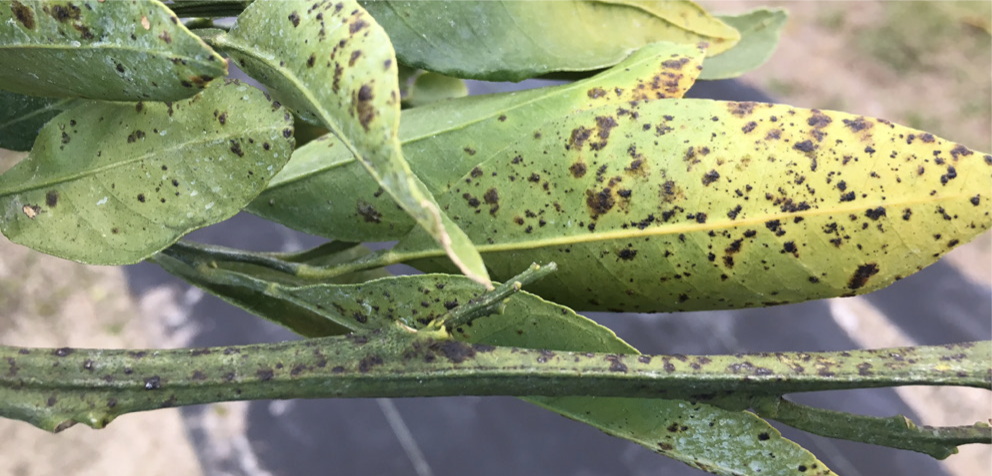
Alternaria: Foliar infection appears as brown spots or blotches surrounded by a yellow halo (Figure 18). Fungicide applications should occur when the spring flush is at one-quarter to one-half expansion and again at full leaf expansion as alternaria can cause fruit drop. If needed, a third spray can be applied shortly after petal fall. Rotate strobilurins with copper. Spores are airborne and most are produced by lesions on mature foliage or foliage on the ground. Planting disease free plants can prevent problems with this disease. Varieties such as ‘Minneola’, ‘Murcott’, and ‘Tango’ are highly susceptible. Satsumas are less susceptible.
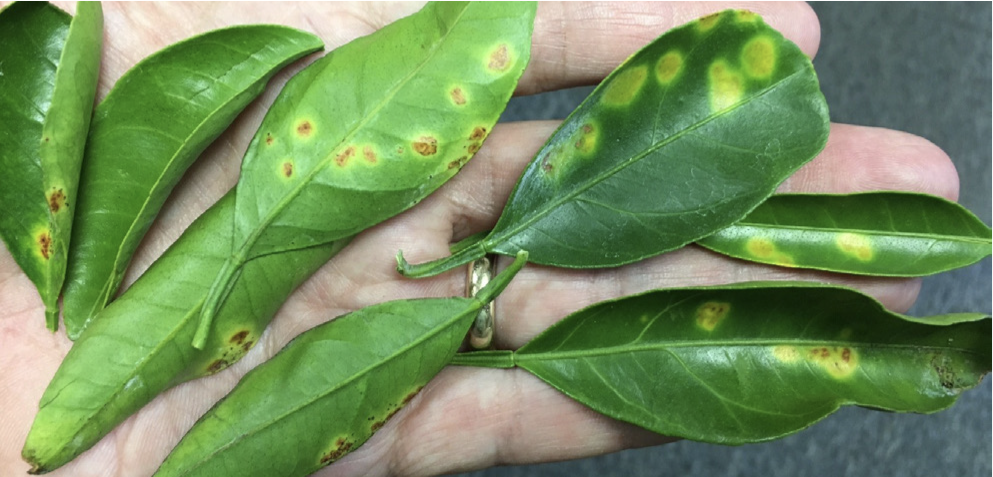
Melanose: Rain splashes asexual spores that originate from dead twigs, which are the primary source of inoculum (Figure 19). Make a fungicide application after fruit-set, usually late April. One application is usually enough for oranges or tangerines. Grapefruit are more susceptible to melanose and should be sprayed every three weeks until fruit reaches 3 inches in diameter.
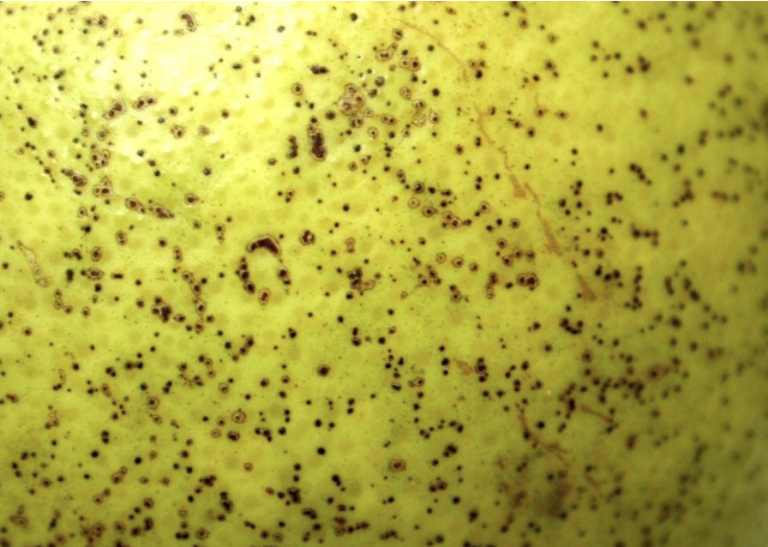
Citrus canker: Canker is a bacterial disease that infects the stems, leaves, and fruit. In severe cases, canker can cause defoliation and limb dieback. New foliage and small fruit are most vulnerable. The disease causes raised lesions on leaf surfaces which eventually become corky (Figure 20). Lesions have a yellow halo. The disease is spread by wind, rain, and the movement of equipment and workers. Canker can also enter the tree through wounds created by citrus leaf miners, so controlling this pest can help to prevent citrus canker infection. Windbreaks can reduce the spread and infection rate where canker is present. Grapefruit and navel oranges are highly susceptible while tangerines are tolerant. Copper can offer protection for fruit but is less effective at protecting leaves. The number of necessary copper applications depends on the citrus variety.
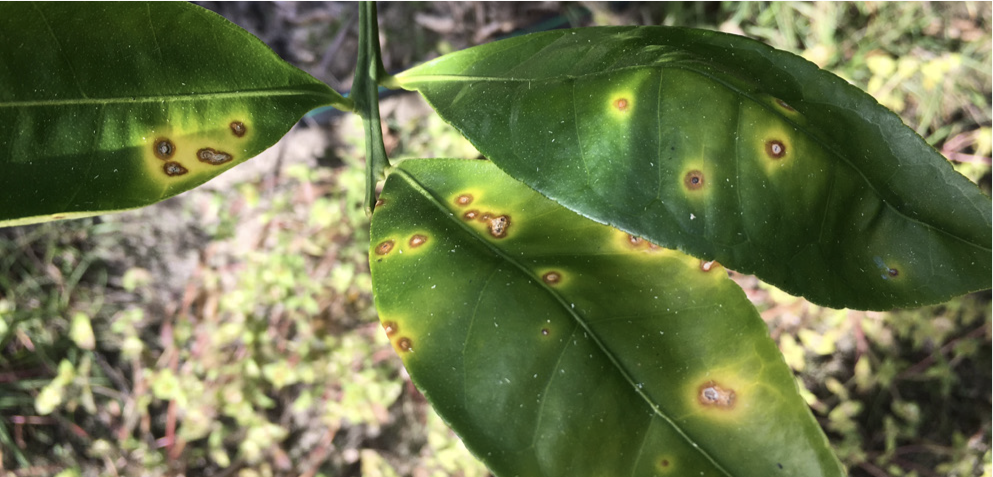
Citrus greening: This disease, also called Huanglongbing (HLB) and caused by the bacteria Candidatus Liberibacter asiaticus, is the most destructive disease of citrus. Early detection is often difficult as the bacteria destroys roots and visual symptoms in the canopy are delayed. An asymmetrical yellow blotchy mottle on leaves is a visual symptom most associated with HLB (Figure 21). Foliage thinning, limb dieback, and fruit drop are common symptoms with advancing disease (Figure 22). Remove the infected tree and roots to prevent the spread of HLB.
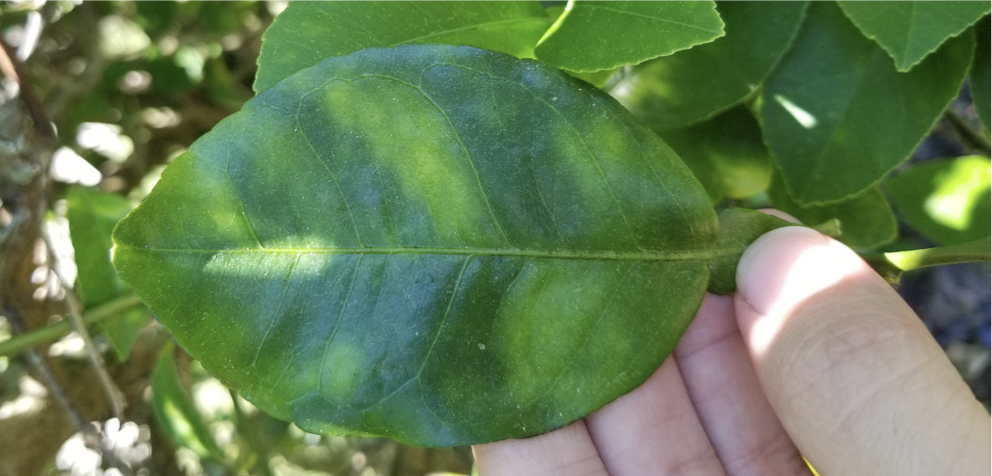
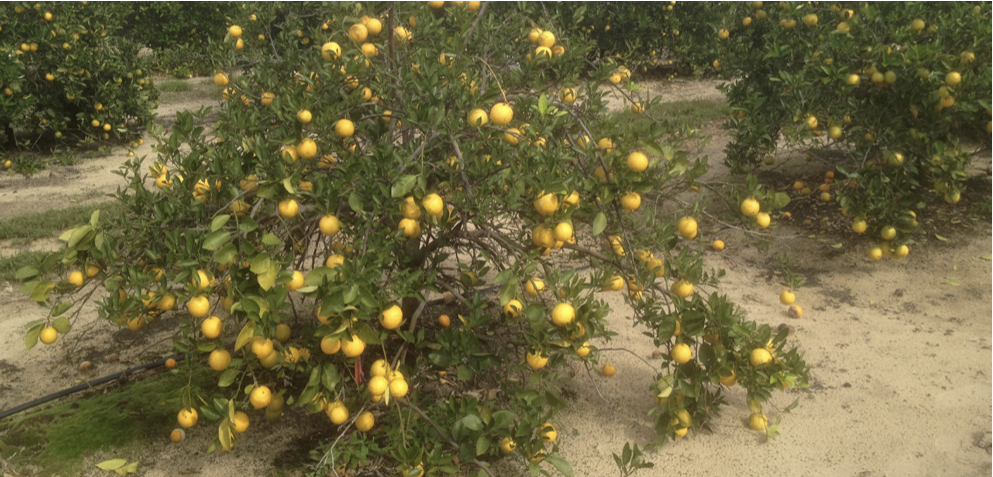
Citrus scab: Scab can be a problem on fresh market fruit, as it causes wart-like protuberances on leaves and fruit (Figure 23). Citrus scab is particularly severe on ‘Murcott’ and ‘Tango’ mandarins. Infection occurs in the spring from water splash of infected foliage and may require treatment. Timing of applications in severe cases are at quarter- leaf expansion, petal fall, and two weeks later.
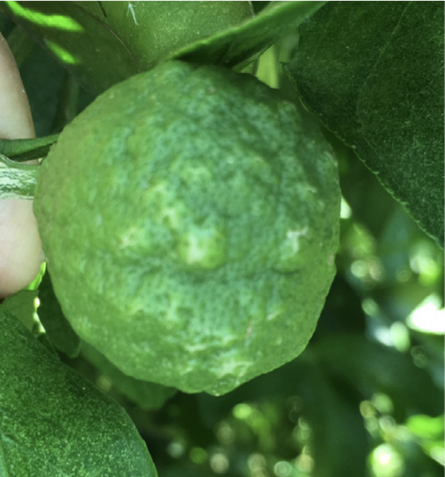
Anthracnose: This infection is caused by the fungus Colletotrichum, which usually colonizes damaged leaf tissue (Figure 24). Anthracnose is common on foliage in spring after a freeze has damaged leaf tissue. Anthracnose is not considered a major problem.
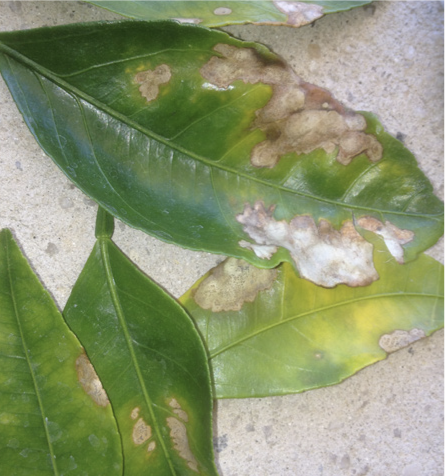
Physiological issues
Fruit sunburn: Sunburn is often a problem on younger trees with less canopy protection. Fruit on the southwest side are more impacted. Fruit symptoms normally begin to show in June as a yellowing area on the exposed fruit. As symptoms progress, fruit can become flattened on one side and the fruit will be dry underneath (Figure 25). Kaolin products may be of benefit.
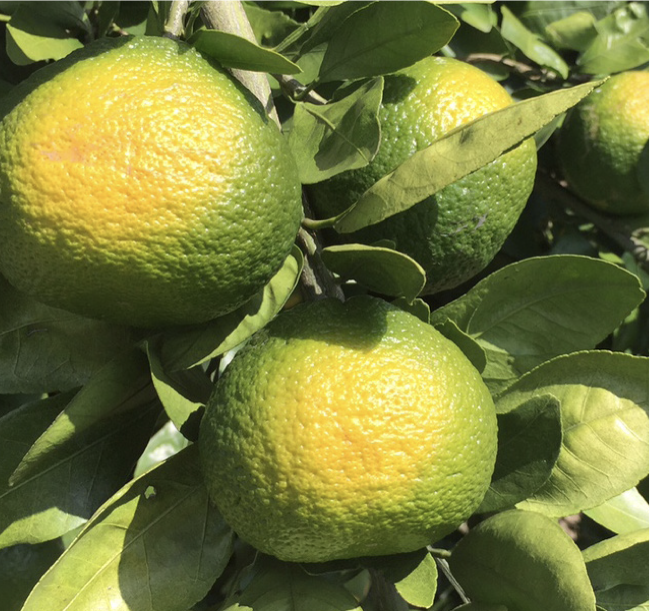
Fruit shed: Fruit shed occurs in most citrus species as trees cannot bring to maturity fruit from every blossom (Figure 26). In satsumas, there is a major fruit shed in April and a secondary drop of larger fruit in late May to mid-June.
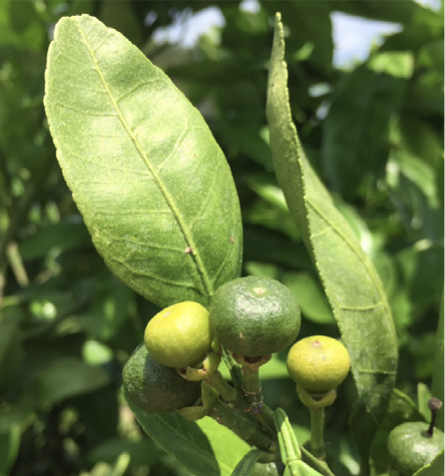
Brown gum spots: This injury primarily occurs on the lower side of leaves as a result of cold damage or sunburn (Figure 27).
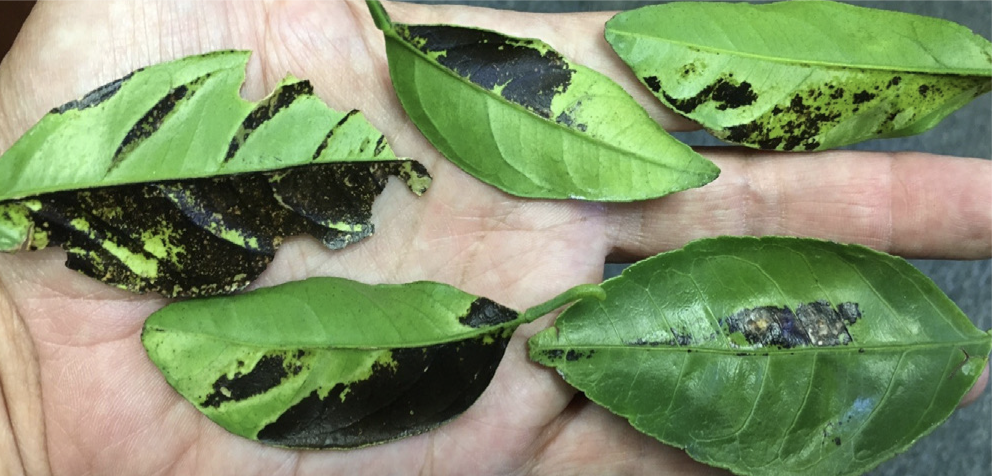
Fruit split: Fruit split is primarily a problem in the fall on younger trees due to a sudden uptake of water. Copper or potassium deficiencies may cause reduced peel thickness. Fruit normally splits on the bottom (Figure 28).
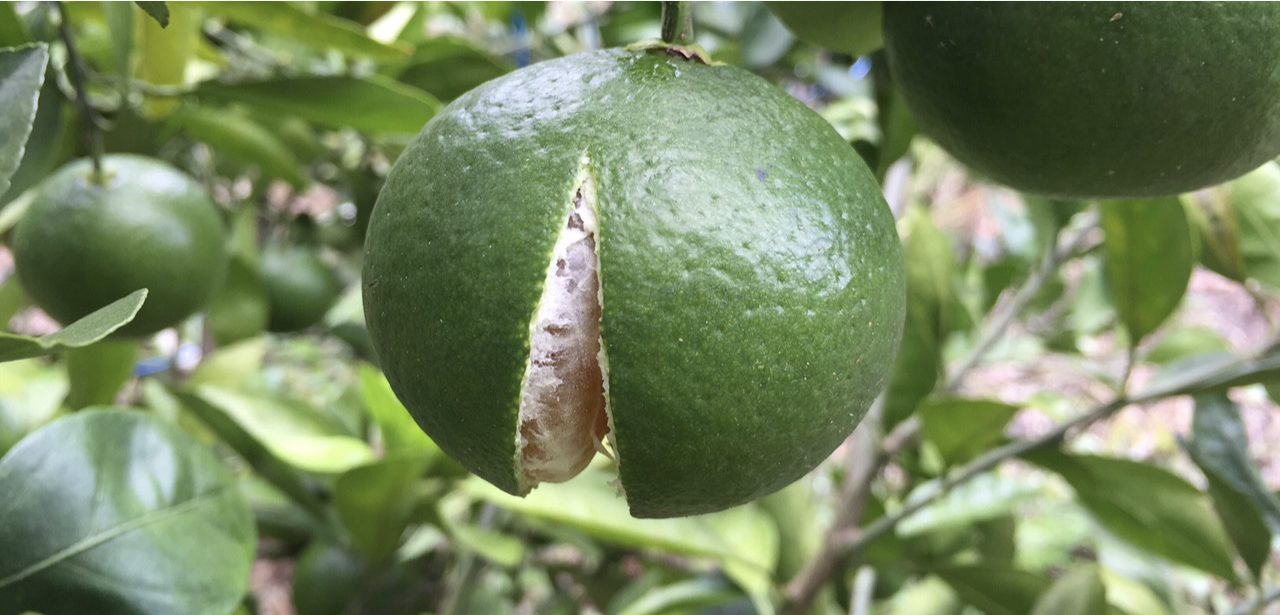
Citrus maintenance calendar
| Maintenance task | Jan | Feb | Mar | Apr | May | Jun | Jul | Aug | Sept | Oct | Nov | Dec |
| Routine maintenance | ||||||||||||
Postemergent herbicide |
x | x | ||||||||||
| Pre-emergent herbicide | x | x | ||||||||||
| Fertilization | x | x | x | x* | ||||||||
| Irrigation | x | x | x | x | x | x | x | |||||
| Prune low branches/rank growth | x | |||||||||||
| Tissue analysis | x | x | ||||||||||
| Windbreaks | x | x | x | x | x | |||||||
| Insect Treatment | ||||||||||||
| Cirtrus lead miners (CLM) | x | x | x | |||||||||
| Leaf-footed bugs | x | x | x | x | x | x | ||||||
| Rust mites | x | x | x | x | x | x | ||||||
| Chewing insect pests | x | x | x | x | x | x | x | x | x | |||
| Spider mites | x | x | x | x | ||||||||
| Orange dog caterpillar | x | x | x | x | ||||||||
| Soft-bodied pests | x | x | x | x | x | x | x | x | ||||
| Asian citrus psyllids (ACP) | x† | x† | x | x | x | x | x | x | x | |||
| Thrips | x | |||||||||||
| Disease Treatment | ||||||||||||
| Greasy spot | x | x | x | |||||||||
| Alternaria | x | x | ||||||||||
| Melanose | x | x | ||||||||||
| Citrus canker | x | x | x | x | ||||||||
| Citrus greening (remove tree) | ||||||||||||
| Citrus Scab | x | x | ||||||||||
| Anthracnose | x | x | ||||||||||
| Physiological issues | ||||||||||||
| Fruit sunburn | x | x | x | |||||||||
| Fruit shed | x | x | ||||||||||
| Gum spots | x | x | x | x | x | x | x | x | x | x | x | x |
| Fruit split | x | x | ||||||||||
|
* In southern parts of zone 8b, fertilization can be split into four applications, including a late July application. Do not fertilize after July to reduce new growth before winter. † Dormant sprays of insecticides in January or February have been found to lower populations of ACP going into the spring without severely affecting beneficial insects. |
||||||||||||
The information in this publication is adapted from:
Diepenbrock, L. M., Dewdney, M. M., & Vashisth, T. (Eds.). (2018). 2018-2019 Florida Citrus Production Guide. University of Florida IFAS Extension. https://crec.ifas.ufl.edu/ resources/production-guide/
Status and Revision History
Published on Oct 04, 2019
Published with Minor Revisions on Jun 06, 2024


























































